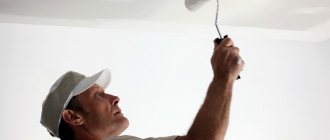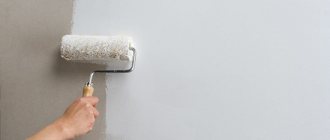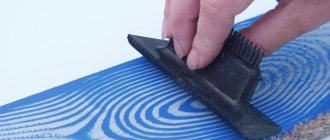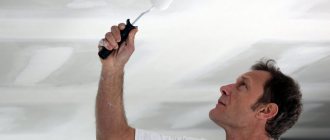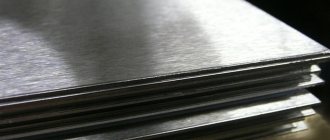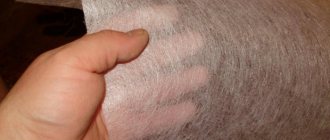Alkyd paints
This type includes enamels based on varnishes, as well as oil paints based on drying oil.
The main advantage of alkyd paints is the environmental friendliness of their compositions. This is why they are widely used for many types of work. In addition, alkyd paints have good covering ability, as well as durability and high resistance to abrasion, moisture and sunlight. The range of use of these paints is quite wide. They can be used to coat wood, ceramics, and metal surfaces. Alkyd paints can be matte or glossy. The negative properties of such paints are a high fire hazard, as well as destructive properties when exposed to alkalis.
Painting walls with acrylic paint
Acrylic paint is a type of water-dispersed paint and varnish materials. This means that it has almost the same advantages. Can be used to dye fabric, leather, porcelain, wood and other surfaces. The composition includes three main components: acrylic polymer emulsion, coloring matter, water. This is what made acrylic paints so popular. There are also other facts that will help you find out the characteristics of the material and the principle of working with it.
Properties of acrylic paint
Krill wall paint is water-based. After applying the composition to the surface, the water begins to dry out, and a durable film forms on the wall. It is moisture-resistant and vapor-permeable, which means that the walls will breathe and the microclimate inside will not deteriorate.
Characteristics and properties of paint:
- Resistant to stains. If the surface becomes dirty, the surface can be cleaned with a damp cloth.
- Versatility. Used for processing reinforced concrete, metal, plaster, plastic, wood and other surfaces.
- Moisture resistant. The original appearance of the coating will not be spoiled; the wall can be wiped with a damp cloth. This will not affect the quality of the surface.
- Fast drying. Water evaporates very quickly after application. It depends on the temperature inside and other factors. After about 2 hours, you can begin applying the second layer.
- Excellent hiding power. High-quality acrylic paint for walls and ceilings can hide minor coating defects, mask cracks and pits up to 0.6 mm deep. It is enough to apply only 2 layers of paint and varnish material to eliminate them.
- Resistance to ultraviolet rays. It will protect the walls and ceiling, and will not fade for a long period.
- It is not afraid of temperature changes, so it is used in the kitchen and similar rooms.
- Environmentally friendly. The composition does not contain a thinner for acrylic paints, and if you do not use such solvents, then the paint and varnish material is suitable for children.
- It is odorless and hypoallergenic.
- Economical. The consumption is quite small and ranges from 100 to 110 g/sq.m.
- Optimal price for such a quality product.
- Rich color palette. The surface acquires rich and bright colors.
Important! When choosing acrylic-based compositions, it is important to consider that when drying, the color becomes slightly darker.
These paints and varnishes are valued for their excellent performance characteristics. They are easy to work with, the composition is elastic, resilient and durable.
We recommend: How to get rid of the unpleasant smell of paint after renovation
Choosing acrylic paint
One of the best is considered to be a water-based acrylic paint and varnish material made on the basis of acrylic resins. Other available options are vinyl caryl, acrylic silicone and styroacrylic. All of them are made on the basis of acrylic copolymers.
Taking into account additional components, acrylic paint is available for interior finishing work, for dry and wet rooms. If you need to paint a dry room, then buy paint for dry rooms, and not vice versa. Can only be used for its intended purpose.
Initially, the paint material is sold in white. To make it colorful, pigment and dyes are used and added to the paint can. The more pigment, the richer and brighter the color. Stores have ready-made formulations with added color.
The paint material can be glossy or matte. The first option will visually expand the room and give it shine. And matte surfaces hide some wall defects. It is recommended to choose a composition from the following companies:
- Tikkurila;
- Siro mat plus;
- Dulux;
- Dufa;
- Innetak.
How to prepare the surface
First, the room is prepared. The furniture is removed or covered with film/paper. The master himself dresses in clothes that he doesn’t mind getting dirty, puts on gloves and a hat.
The walls and ceiling are cleaned of old finishing material. Use a spatula or sponge, depending on the finish. For convenience, it is moistened with warm water. Particular attention is paid to the corners and junctions of the wall and ceiling.
All cracks, crevices, and depressions must be removed. The surface must be perfectly flat, clean and dry before painting. Putty will eliminate defects. The final stage is priming the walls and ceiling. It will improve adhesion and reduce consumption.
If you intend to paint a wooden surface with acrylic paint, it must first be primed. Then the wood will not absorb the composition into the pores, increasing consumption.
Preparing paint and tools
Initially, acrylic paint is thick. This is both good and not so good, because the thickness will not allow you to hide the joining stripes when painting. It is diluted with water so that the painted surfaces look perfect. The manufacturer indicates the optimal consistency. Typically you need to add 5-10% water to the jar.
There are paints that do not need to be thinned. The instructions simply say “stir.” In most cases this applies to painting in 1 layer.
To paint the walls and ceiling you will need a brush or roller. The brush is used for hard-to-reach places (corners, areas behind the radiator), and the roller is convenient and quick to work on different surfaces. It is recommended to purchase a tray along with the roller to control the amount of paint. A rag is required to remove errors.
Painting with a brush
Apply the paint carefully to avoid smudges. There is no need to put a lot of acrylic composition on the brush. For control, a rubber band is pulled over the can, thanks to which excess paint is removed. You cannot wipe the brush on the jar itself.
When applying, the tool is held perpendicular to the wall or at a slight angle. Movements are smooth and uniform. The stripes are formed wide, then they are shaded. The handle is kept as close to the surface as possible, and as you move, the angle of inclination increases. The appropriate composition is used to finish the ceiling. Painting walls with ceiling paint is not recommended.
To get a smooth surface, the applied strokes need to be crossed: one stroke up, the other down. From time to time the brush is rotated 180°. The bristles will wear evenly.
Due to the rapid drying of acrylic paint, the brush should not be allowed to dry out during breaks. She'll get stunned. After finishing work, the tool is washed with solvent.
Roller painting
Working with a roller is easier and faster. Acrylic paint is poured into a tray, a roller is lowered into it and by rolling it over the tray, the tool is saturated with it. This will allow you to remove excess diluted liquid and paint the ceiling without streaks.
The further process is simple: painting begins not from the corner, but from 1 m from it. The paint and varnish material is distributed over the surface, while the roller is pulled away from you. Strokes are made crosswise relative to each other. This will allow you to leave no traces and distribute the composition evenly over the surface.
Dyeing technology
Let's take a closer look at how to paint walls with acrylic paint. If, while working with a brush, you press hard on it, smudges will form, the layer will be thin, and the strip will be wide. By applying gentle pressure, the stripes turn out narrow and with gaps. Ideally, at first, apply light pressure, and when there is less paint on the brush, increase it.
We recommend: Paintable wallpaper: how to glue and paint
We recommend that before using acrylic paints, try yourself on an unnecessary surface and get your hands on it. The staining steps are as follows:
1. The first layer is applied parallel to the rays of the sun. Start from corners and hard-to-reach places.
2. After drying, a second layer is applied, it is perpendicular to the first. The technology is the same.
3. The third layer is perpendicular to the second. Since the mixtures contain water, the layer will dry quickly. The main thing is to distribute the substance well so that smudges do not form.
After each layer, the quality of the paint is checked, depending on the correct application. No gaps or stripes. If there are any, they are corrected before the dye dries.
Acrylic paint is one of the best materials in its field. It is easy for a beginner to work with. It is durable, protected from moisture and does not fade over time. In addition, there is no smell, after painting you can move in immediately. Since the composition is environmentally friendly. It can be used in any room.
Emulsion paints
The class of emulsion compositions combines acrylic, water-dispersion, polyvinyl acetate and latex paints. Thanks to the polymer particles that are part of latex and acrylic paints, when dried, a thin elastic film is formed that has fairly durable properties. In water-dispersion paints, the pigment and binder are diluted in an aqueous medium. After polymerization of the paint layer, the coating becomes resistant to water. The paint adheres well to various surfaces that do not have a glossy finish.
Material advantage
Compared to oil compositions, acrylic ones have a number of technological advantages:
- They dry quickly (one to two hours is enough), and can be applied even to a slightly damp surface . Quick-drying compositions have also been developed, which require 30 minutes to dry completely. This makes it possible to speed up the work process when finishing the interior.
Interior latex acrylic paint
- After drying, the material, unlike oil paints, does not fade in the sun or fade, and retains its original color for a long time . The treated surface retains natural ventilation, i.e. it “breathes”, so they are ideal for painting the facade and interior of wooden buildings.
- The quality of the finishing layer can only be assessed after it has completely dried . In this case, cracks and various deformations do not occur, which is typical for oil analogues. The material can withstand small temperature changes.
- Acrylic paints are not difficult to work with . For example, residues from tools can be easily removed with plain water without the use of chemical solvents.
Compositions for treating walls outside
Paint that gets onto unwanted areas can be removed without damaging the already painted surface. During the dyeing process, no toxic substances are released into the air; as it dries, water evaporates.
In addition, the price of this group of paints is lower than oil-based materials, which also adds to their attractiveness among consumers. They are produced in cans (volume 0.5-4 l) and tubes (60-200 ml). The first are intended for construction work, the second for artists.
Recommendations for application
Before you paint with acrylic, you must understand that the technology of painting with water-dispersion paints is directly related to the surface being treated and the result that you want to get in the end.
They can be applied in different ways, and it depends on the complexity of the work.
However, there are recommendations on how to properly paint with acrylic paint, which must be followed regardless:
- Dilute acrylic paints either with water or solutions specially developed by manufacturers.
- Do not add solution or water directly to the paint container. Use a separate container for dilution, into which you first pour the required amount of the composition.
Water-based mixture for facade work
Tip: It’s better to dilute a small amount of paint several times than to dilute all of it at once. Otherwise, after the water evaporates, the material will simply dry out and be damaged.
- Before sealing a paint can so it can be used again, thoroughly clean the area where the can and lid come into contact. If you don't do this, the remaining paint may dry out so much that it will no longer be possible to open the can.
- After finishing working with acrylic paints, immediately rinse the tools with water. Then you can quickly clean them and use them in the future; after the paint has dried, this will be much more difficult.
- Work only with specially pre-prepared paint. Depending on the complexity and type of work, it should be diluted with water or a special solution, and maybe even thickened to a paste. Thanks to this preliminary preparation, acrylic water-dispersed or water-based paints have good adhesion to the base, allowing them to work even in difficult weather conditions.
We recommend: MA-15 paint – description, technical characteristics and varieties
Solutions used for dilution are divided into two types:
- for a matte shade;
- for shiny.
Tip: if you decide to do wall painting, you must know these properties of the materials.
Application
So, what can you paint with acrylic paints yourself?
Below are three surfaces most often encountered in repairs:
- Painting non-woven wallpaper with acrylic paint yourself requires some skill. If you don’t have enough of it, use the simplest method - choose wallpaper with a repeating pattern and a uniform structure.
Painting non-woven wallpaper with an acrylic mixture
For work, prepare tools, the better to apply acrylic paint specifically for you, for example, a roller, brush or paint sprayer to paint the outer layer. A more complex method involves painting from the inside or wiping off the paint after application.
Whatever method you use and regardless of your skill, follow two rules:
- use only water-based paints without adding impurities harmful to humans;
- Before the process, take a small piece and do a test painting, so you can see the final result with your own eyes.
- Acrylic paints and plaster. In this case, the features of the latter should be taken into account. The surface must be dry, clean and level, old paint must be removed in advance.
Advice: pay special attention to sealing cracks, and the plaster before painting should be polished with fine sandpaper.
We paint the plaster ourselves
So how to apply acrylic paint? This should be done on a primed surface before painting in one direction.
Use some recommendations to get the desired result:
- Tape the ceiling and adjacent walls in the corners with masking tape so as not to stain adjacent surfaces. Thus, you will not need to rush to remove the paint from them later;
- choose the right tool for the job. The roller, for example, should have long pile. This will help speed up the work process and apply the material more evenly to the surface;
- dilute the paint for the roller in a wide special container; it should also have a corrugated surface to remove excess paint.
- The use of acrylic paints for concrete surfaces allows them to be protected from damage, wear and dust. In addition, application of the material allows:
- give it an aesthetic appearance;
- improve performance characteristics;
- protect from chemicals.
Like any other material, acrylic paint is applied to concrete according to technical instructions and recommendations. The surface must first be cleaned of dirt, dusted, washed with water and dried, but priming is not necessary. The instructions allow you to apply the material even at sub-zero temperatures, which sets it apart from others.
Painting concrete with acrylic
Water-based acrylic paints are also used for concrete. Their main positive characteristics are non-toxicity and fire resistance. In addition, they are resistant to alkaline solutions.
Adhesive paints
The main components of such paints are mixtures of adhesive components and fillers. Adhesive paints have a powder composition, so they must be diluted with water before use. Their properties are similar to water-dispersion paints, they are very easy to use and are easy to wash off the skin of your hands. Of all types of paints, adhesive paints perhaps have the lowest resistance to mechanical stress, as well as to the influence of sunlight.
The main condition before painting the surface is a mandatory preliminary primer. The primer will ensure strong adhesion of the paint to the material, making it a strong base for the coating.



